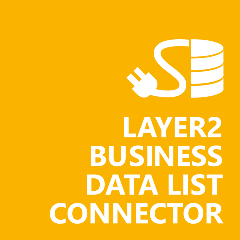Layer2 Cloud Connector: Connect 150+ systems and apps in minutes to keep pre-selected data in sync. SQL, ERP, CRM, Office 365, SharePoint, Azure, and more.
Solutions for Safe & Seamless Data Integration
Data integration works by bringing together data from various sources, formats, and locations. Layer2 Solutions is one of the leading providers of apps for Microsoft Office 365, SharePoint, and Azure with a major focus on data integration and cloud computing. You will find solutions for general data integration, Microsoft Office 365 / SharePoint Online data synchronization, file migration, backup, and document synchronization below. SharePoint Server 2013, 2016, 2019 and 2022 Subscription Edition on-premises is also supported.
Data integration and migration - for more than 150 systems
Below you can see different systems you can connect. If you want to explore our complete overview of all systems, please click here.
Advantages of data integration
Integrated data offer many advantages for companies. We summarize some of them for you here.
- Unified view of data
Data integration enables organizations to consolidate data from disparate sources into a single, unified view. This unified view provides a comprehensive understanding of business operations, customers, and other critical aspects, facilitating informed decision-making. - Improved data accuracy and consistency
By harmonizing and reconciling data from various sources, data integration helps ensure consistency and accuracy. This reduces the risk of errors, duplicates, and discrepancies, enhancing the reliability of data for analysis and reporting purposes. - Enhanced data accessibility
With data integration, organizations can access data from different systems or databases more easily. This improved accessibility promotes collaboration, empowers employees to make data-driven decisions, and accelerates response times to business needs. - Increased operational efficiency
Automating the process of extracting, transforming, and loading data (ETL) through data integration solutions boosts operational efficiency. It reduces manual effort, minimizes the time required to prepare data for analysis, and frees up resources for more strategic tasks. - Holistic analysis and insights
Data integration enables organizations to analyze data from multiple sources simultaneously, providing a more holistic view of their business environment. This leads to deeper insights, enabling organizations to identify trends, opportunities, and potential risks more effectively. - Support for decision-making
By providing timely, accurate, and relevant data, data integration supports better decision-making across all levels of an organization. Integrated data empowers decision-makers with the information they need to drive success. - Improved customer experience
With integrated data, organizations can gain a unified view of customer interactions, preferences, and behaviors. - Compliance and risk management
By centralizing data management and ensuring adherence to regulatory requirements, organizations can mitigate risks associated with data breaches, privacy violations, and non-compliance.
Frequently asked questions about data integration
We will answer several common questions about data integration here. If you have any further questions, please contact us.
What best defines data integration?
Data integration best defines that it refers to the process of combining data from different sources or formats into a unified view, typically for analysis, reporting, or decision-making purposes. It involves harmonizing, reconciling, and transforming data to ensure consistency and compatibility across various systems or databases.
What is a simple example of data integration?
A simple example of data integration is merging customer information from a company's sales database with their marketing database. By combining these two datasets, the company can gain insights into customer behavior, preferences, and purchasing patterns, which can inform targeted marketing campaigns and improve overall customer experience.
Who needs data integration?
Organizations of all sizes and across various industries need data integration. Businesses, government agencies, educational institutions, healthcare providers, and non-profit organizations all require data integration to streamline operations, gain insights, improve decision-making, and enhance overall efficiency.

